Girls in view - their future in the port, 2012

"Girls in view - their future in the port"
Große Elbstraße 210-212, Steps between buildings XII and XIII.
Design and realisation: Group of 9 girls in a painting class at the Art Gallery,
under the guidance of Hildegund Schuster. - Curator: Elisabeth von Dücker.
Cooperation: Hamburg Art Gallery-Education and Mediation,
Hamburg Vocational College, Hamburg Chamber of Skilled Crafts.
Sponsors: Altona District, Friends of the painting class in the Art Gallery,
Lewien Foundation, GEW Education and Funding, ver.di, HASPA Foundation,
Aurubis AG, Stempel OHDE.
- Photo: FrauenFreiluftGalerie Hamburg ©
The Women's Open Air Gallery continues to grow and a new mural has been produced in Große Elbstraße in Altona.
The subject: prospects for young women in the port of Hamburg: vocational and career chances for women in the skilled crafts and technical jobs.
The patron of the mural s Jana Schiedek, Hamburg's Senator for Justice and Equal Opportunities.
She gave a speech during the official inauguration of the mural at 4.30 pm on 7 August 2012 (see below).
The mural is a creative project that combines artistic goals and social concerns.
She Women's Open Air Gallery Hamburg is run by the Hamburg artist Hildegund Schuster and the art historian Dr Elisabeth von Dücker.
The Chamber of Skilled Crafts with its Vocational Academy (see speech below) and Hamburg Art Gallery with its traditional painting class are cooperation partners for the project. The artist Hildegund Schuster has been involved in the painting class as course leader for many years.
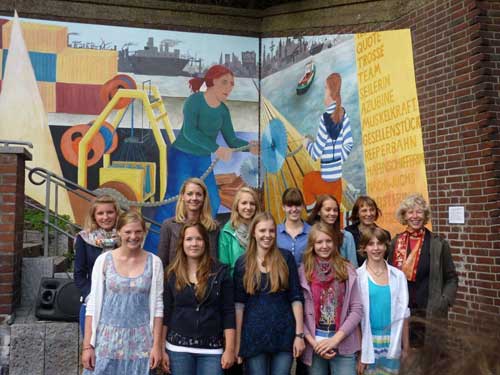
Official inauguration on 7 August 2012 with the group of girls,
with Senator Jana Schiedek (2nd on the left in the second row)
and with project leaders Hildegund Schuster and Elisabeth von Dücker.
Photo: Sven Billhardt ©
Nine school girls aged between 13 and 18 years created the mural under the artistic guidance of Hildegund Schuster, curated by Elisabeth von Dücker.
Work on the painting itself was preceded by a number of investigations prepared by the project leaders and supported by Dr Marianne Ludewig from the Vocational Academy Hamburg. This entailed visiting businesses and workplaces in the port . The school girls had an opportunity to talk to women working as a rope makers and a sail makers for example, also learning about the work performed by women in carpentry, electronics, boat building and in port shipping as skipper on a launch.
Our questions: Which businesses offer young women apprenticeships in skilled crafts and technical jobs? And in jobs that used to be dominated by men, e.g. electronics, sail making, port shipping? What is it like to work in the businesses? Who offers what kind of apprenticeships? Do gender problems still exist?
The intensive phase of producing the sketches and designs was followed by working in the open air. This involved measuring the surfaces of the three walls, cutting the aluminium Dibond panels to size and affixing them to the brickwork, applying the grid plan, transferring the lines of the design, applying the actual paints and, most important, discussing everything all the time, whatever the wind and weather, during the very limited weekend hours in term time. The project ran from 30 April to 11 July.
Intention of the mural project: To give an insight into the reality of working life. The aim was also to make the girls curious about working in the port with the job prospects it offers women although it is still often seen as a "men's world". The project also wanted to encourage girls to become young female role models and identification figures.
What the girls wanted: "We liked the idea of helping to shape the appearance of the city. It's somewhere we can bring our children in years to come". An ideal means of identifying with Hamburg.
They were also fascinated by the insights into the often unknown working worlds in the port and by this opportunity to break new ground.
In terms of demographic change, inviting young women to take a look at jobs previously dominated by men is an appealing and seminal perspective.
These girls were involved: Alaida Hobbing, Alina Hildebrandt, Annika Meier, Hannah Günther, Josefine Ederhof, Katharina Moll, Merle Plamböck, Rahel Krüger, Sophie Le Mercier.
Site of the mural: at the steps in Große Elbstraße 210-212, Altona Fish Market, between buildings XII and XIII. The mural is in a favourable position in public space with lots of people going past; it connects Altona and the port-related areas along the river Elbe.
Download of the invitation to the official inauguration (german)
Speech given by Senator Schiedek,
patron of the girls' mural:
Ladies and Gentlemen, Dear Artists
As a Hamburg lass, I am naturally of the opinion that Hamburg is the most beautiful city in the world. The river Elbe and the port are my favourite place. Here you can feel the wind of the big wide world on your face. Container ships from all four corners of the earth use Hamburg as a transit point for their goods, while large cruise liners have become a real tourist attraction: there was in port just recently. Big ships, little launches, seamen, captains and skippers, shipowners, merchants, shipyards, stevedores and harbour tours have long characterised life at, with and on the river Elbe.
For many years, the port and shipping seemed to be a purely men's world. Seafaring romance only knew women in the role of seamen's brides or "alley cats". But women's work has always played a very significant role in the port and its associated industries, even if this work was almost invisible. And there's no truth in the rumour that seamen's wives spent all their time sitting at home waiting. Indeed, they often became self-confident, self-assured personalities who then really struggled to cope with the change in their domestic roles when their husbands came home from sea and wanted to take over again.
Since 1994, the Women's Open Air Gallery Hamburg has been telling us about the work done by women in the port of Hamburg since the days of the German Kaiser. Back then it was taken for granted that women in the port only worked in jobs that needed "typical feminine" dexterity and patience or were related to domestic tasks. They worked in fish processing, they sorted coffee beans and hazelnuts, they packed fruit, they did the cleaning or helped out in the warehouses or in the snack bars for the dockers.
But modern times have fortunately not passed by the port and its shipping. Already in 1979, the "Handelsblatt" business newspaper published the following report about women working on board: "The seafaring world, formerly a decidedly rough male business, is increasingly offering work for the fair sex. Even the engine room, meanwhile one of the last male bastions on board, has now also succumbed. Two young women who want to become ship's engineers are currently going to sea for the Hamburg shipowner F.Laeisz."
Today's ports are also completely different in appearance. The ships are huge and packed with containers. Machines do the hard work where brawn used to be needed. This has led to new jobs with interesting prospects for girls and women, also or particularly because they don't comply with the traditional ideas of "girls’ jobs". We can see a few good examples here in front of us: in preparing the mural, the young artists have met women working in port shipping, electronics, sail making, rope making or boat building. This can and should encourage other girls and young women to deviate from the old traditions when choosing their future career.
The girls' mural of the Women's Open Air Gallery which we are officially inaugurating today has exactly this intention: to arouse interest in the port and its jobs and the possibilities and chances for future development that women can find here. Just one of the reasons why I was happy to become patron for this super project: not just because I used to work in the port of Hamburg before I became senator, but particularly also because this project is a wonderful combination of artistic creativity and commitment to equal opportunities.
I would therefore like to take this opportunity to say thank you to the two project leaders, Ms Schuster and Dr von Dücker. Many thanks also to the school girls for all the motivation they showed in their investigations of businesses and workplaces in the port before preparing and painting the mural.
The mural "Girls in view - their future in the port" depicts some of the many job prospects for young women in the port, in sail making, carpentry or port shipping. Jobs that are still not automatically done by women. That's because we're still miles away from really equal opportunities for men and women in the working world. Although girls usually obtain higher and better school qualifications, they don't have the same chances as boys to put these to good effect in their careers.
The reason for this is that despite offering outstanding qualifications, girls still don't think they will be able to choose their careers from the full range of future-oriented jobs. On leaving school, most girls still focus on just 25 jobs, many of which offer no realistic future prospects. Girls continue to put hairdresser and shop assistant at the top of their list of favourite jobs.
Both men and women still tend to opt for gender-dominated vocations. And despite all the options presented by careers guidance, there are still far too few signs of any real change in the way youngsters choose their future career, despite slight improvements in the number of women doing at least some hitherto male-dominated jobs. This applies for example to the legal profession, where women have increased their share by 9 percentage points over the last ten years to reach 40 percent meanwhile.
It is important for other sectors to catch up soon, including technical jobs. What we want is for girls and women to have quite natural access to every job. And not just because of the skill shortage in so many areas. It's about the whole principle of equal opportunities and gender equality for girls and women.
Leaving school to start work is often so much more than merely choosing a career. This is when the course is set for the rest of their lives. Of course girls should continue to follow their own inclinations in their choice of career. But their decisions should give due consideration to the career prospects and potential income that the job of their choice offers them for the future. Will they be able to fulfil their own personal expectations and desires for their lives? When all is said and done, the way a career is chosen is one of the reasons why men still earn more than women.
The issue of women in the working world is therefore a central focus of the equal opportunities programme that is currently being elaborated in the Department for Justice and Equal Opportunities.
Ladies and Gentlemen,
Girls leave school today with good qualifications that make girls and young women ideally equipped to follow new paths and to take courageous and even unusual decisions in their choice of career. I would like to give them every encouragement to do just that, with the reassurance that Hamburg Senate will give you all its support. The young artists who have produced the new mural have already taken a step in the right direction, by showing us what is possible.
Many thanks.
Speech from the Vocational Academy Hamburg for the inauguration of the girls' mural
by Professor Dr Uwe Schaumann
„Girls in view - their future in the port“
Dear visitors to the Women's Open Air Gallery,
As Director of the Vocational Academy Hamburg, I am unfortunately not able to be present in person today to speak to the initiators and founders of the Women's Open Air Gallery. But I would still like to take this opportunity to express a few thoughts.
Since 1994, the Women's Open Air Gallery and above all the two women running the project, Dr Elisabeth von Dücker and Hildegund Schuster, have embodied an idea that is simply without parallel. Meanwhile the Women's Open Air Gallery is known as a long-term project way beyond the city limits of Hamburg. The project constitutes a successful synthesis in many different ways.
The project itself with its numerous works is already a directly recognisable synthesis between the normally male-dominated view of "hard port work" and the ultimately indispensable and definitely important role played by the women working in and for the port.
But the project is also a synthesis between the way we experience, recognise and possibly even fear the short-lived spirit of our times on the one hand, and the very present and sometimes concealed longing to linger, to pause and hold onto the moment, perhaps with the added possibility of an unexpected feeling or completely personal insight.
At the same time, the project is a synthesis between the past and the present. And when we look at the title of the mural "Girls in view - their future in the port", we also see a link to the future in the port and beyond. In the end, this is also a most successful synthesis between everyday life in the port and the world of art.
And it's exactly this kind of synthesis that we need as an inspiration and incentive to acquire a feeling of our own significance and subjectivity. Here art can be seen as a benevolent complement to science. Science often looks for the unequivocal, objective and precise explanation of cause and effect. According to my very amateurish but definitely interested understanding, art as visualised and perceived here in the Women's Open Air Gallery has another, different task. It doesn't try to explain things. It is understood in a fundamentally different way by each individual. It doesn't point fingers and say what's allowed and what's not allowed. It is up to the observers to have their own personal impressions.
Even if I haven't been able to take a look at the new mural yet, I am convinced that this picture too will depict a successful synthesis between art and everyday life in the port.
The whole topic of "Prospects for young women in the port of Hamburg: vocational and career chances for women in the skilled crafts and technical jobs" is of course particularly interesting for the Vocational Academy Hamburg as the training facility for skilled crafts in the city.
In recent years and decades, the skilled crafts have offered interested and committed women a wide range of training and career possibilities. Here people tend to think first and foremost of hairdressers, but even if this is still a very attractive job for women, the so-called typical men's jobs also offer women a wide range of opportunities. These include opticians, bakers, carpenters, metalworkers, painters and decorators or electrical technicians. Today the skilled crafts also offer the possibility of combining vocational training with an academic degree. There are many jobs here in the port and its surroundings, where many motivated young people are needed. For a long time now, women have no longer been the exception here.
The prospects for young women in the port of Hamburg today are probably much better than they used to be.
One reason for this is that we no longer have the same stereotype image of women in our heads. There is evidence all around that women will and can stand on an equal footing with all people, men and women alike, even though the opportunities to do so are still too few and far between.
What we need is projects like the Women's Open Air Gallery and people like Dr von Dücker and Ms Schuster to uphold and improve the visibility of women in the port of Hamburg and beyond.
May I therefore take this opportunity, Dr von Dücker and Ms Schuster, to congratulate you on the new girls' mural! I wish you and all current and future visitors that you may all be open for the odd surprise now and experience as much as possible in all you see and do.
With kind regards
Professor Dr Uwe Schaumann
(Vocational Academy Hamburg)
Picture gallery
Creating the mural
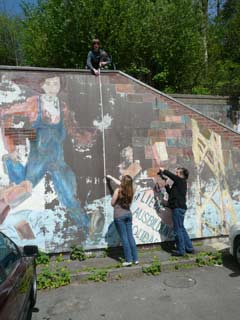
Measuring the old mural to
produce the design.
Photo: Elisabeth von Dücker ©
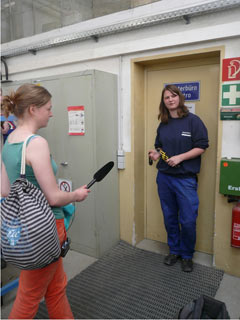
Portrait „Corinna D., seamen’s deacon“.
Photo: Peter Breucker ©
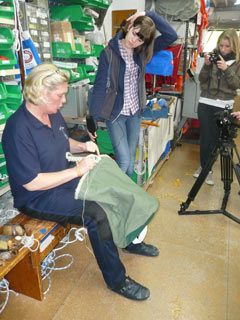
Annika interviews the
electronics technician.
Photo: Elisabeth von Dücker ©
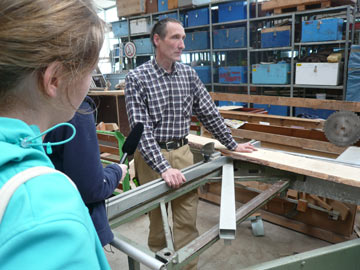
Listening to the instructor in the carpenter's workshop.
Photo: Elisabeth von Dücker ©
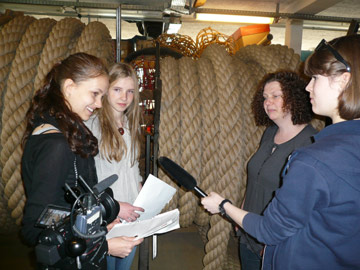
Interviewing the rope maker.
Photo: Elisabeth von Dücker ©
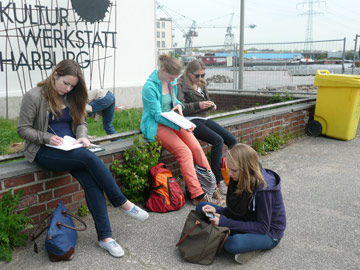
Sketching in the open air after visiting a business.
Photo: Elisabeth von Dücker ©
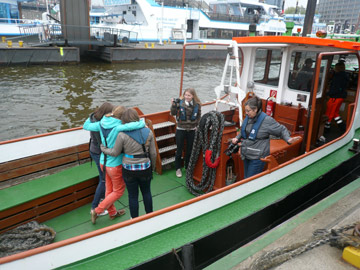
Visiting the port skipper, with film maker Leslie Franke.
Photo: Elisabeth von Dücker ©
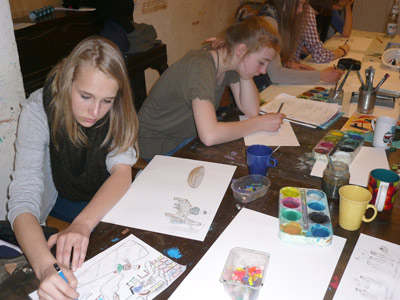
Working on the designs in the art gallery.
Photo: Elisabeth von Dücker ©
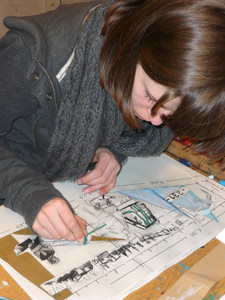
The designs are nearly ready.
Photo: Elisabeth von Dücker ©
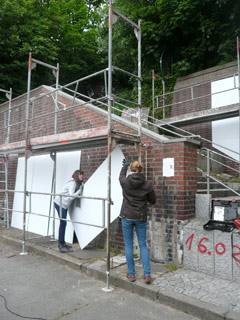
Mounting the panels.
Photo: Elisabeth von Dücker ©
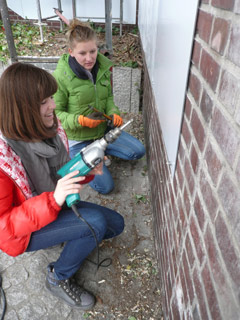
Using the power drill in even
the most awkward places.
Photo: Elisabeth von Dücker ©
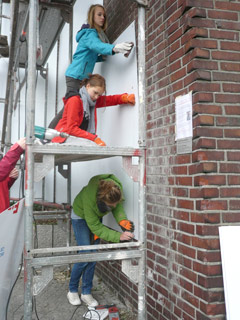
Screwing and roughening.
Photo: Elisabeth von Dücker ©

Painting the skyline.
Photo: Elisabeth von Dücker ©
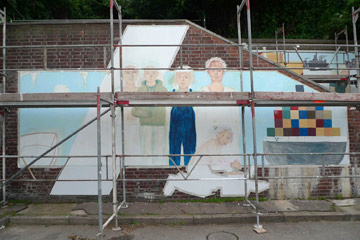
Half-way through in July.
Photo: Hildegund Schuster ©
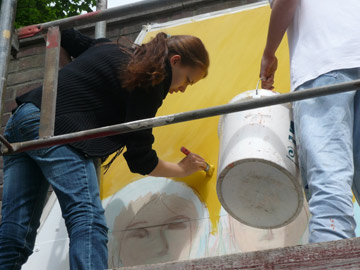
Katharina paints the background.
Photo: Elisabeth von Dücker ©
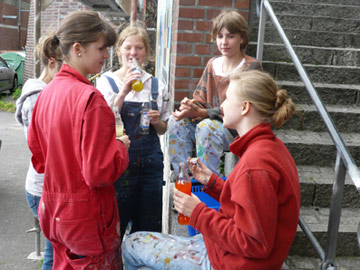
Sophie, Annika, Rahel and Alaida having a break.
Photo: Elisabeth von Dücker ©
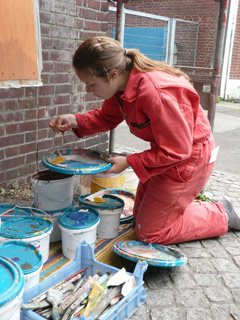
Hannah fills her palette with paint.
Photo: Elisabeth von Dücker ©
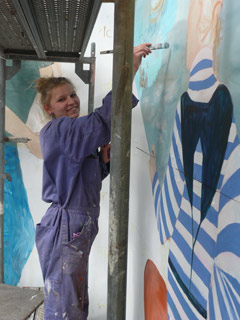
Merle and the water.
Photo: Elisabeth von Dücker ©
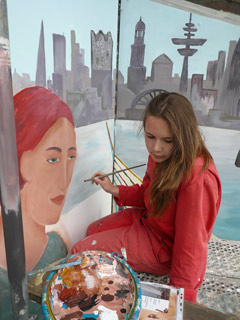
Hannah and the rope maker.
Photo: Elisabeth von Dücker ©
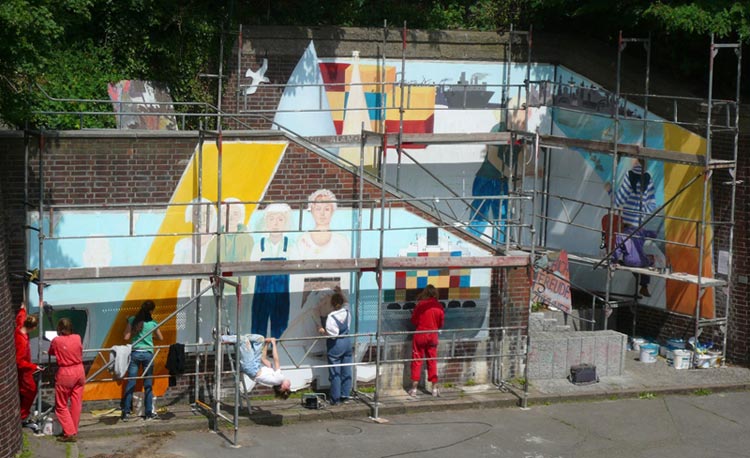
Daily routine at the mural.
Photo: Elisabeth von Dücker ©
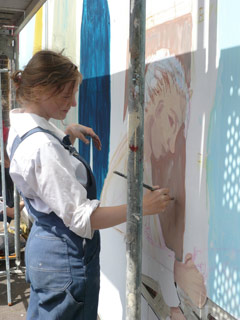
Annika paints the carpenter.
Photo: Elisabeth von Dücker ©

The press have come to see what’s going on: journalists from the Hamburg evening paper visit the girls' mural.
Photo: Elisabeth von Dücker ©
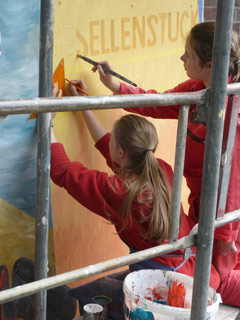
Alaida and Hannah produce the word strips
Photo: Elisabeth von Dücker ©
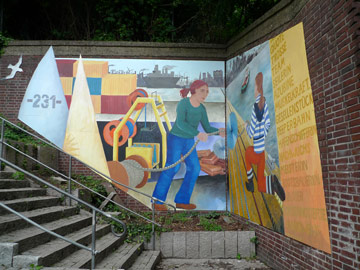
The corner behind the steps.
Photo: Elisabeth von Dücker ©

Working women.
Photo: Hildegund Schuster ©

Official inauguration on 7 August 2012 with the group of girls, with
Senator Jana Schiedek (2nd on the left in the second row) and with project leaders Hildegund Schuster and Elisabeth von Dücker.
Photo: Sven Billhardt ©

